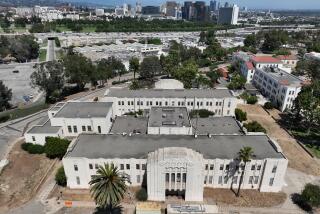Rebirth of a Landmark
When Mercy Charities wanted to build low-income housing for senior citizens in Oxnard, it set its sights on the grounds of the old Swift Lying-In Hospital, where expectant mothers flocked to have their babies half a century ago.
Rather than raze the Spanish-colonial style hospital on West 5th Street--an idea neighbors in the historic district opposed--the developers renovated it and built a larger structure behind it with the same white stucco walls and red tile roof.
They ended up with a 40-unit apartment complex, Casa Merced, that was designated Friday as a Ventura County historic landmark.
Once skeptical of the project, city and county officials and residents eventually turned out to praise it. And seniors who moved in this spring sang the virtues of the cheerful grounds and classic California architecture.
Converting unused institutional buildings such as hospitals and schools into residential properties is an idea that has become popular in many cities across the country, from Atlanta to Los Angeles.
The trend is not common yet in Ventura County. But a 98.5% apartment occupancy rate and strict anti-growth policies have created a challenge for renters of all income levels countywide. Today, real estate agents and developers say, such conversions--also known as “adaptive reuse”--are probably on the horizon.
“There’s not enough housing and there’s going to be more demand,” real estate agent Donna Moore said. “Why tear down a building and build another one when the structure’s there and it’s a good location?”
Moore said she fields many calls from prospective renters looking to live in quaint nooks above downtown Ventura shops. She doesn’t have many places to show them. “More and more people are wanting to live in a downtown area,” she said. “There’s beautification programming. People like to walk around at night.”
Jeff Becker, president of The Becker Group in Ventura, said such conversions are generally economically feasible. But Ventura County isn’t as full of glorious old institutional buildings as many other urban areas.
“We don’t have much in the way of old warehouses and schools that can be converted,” he said. “What we do have out there, the developers and people who own that property are probably considering that now.”
Becker’s company is renovating what was once the Henshaw Hotel in downtown Ventura into compact, high-end apartments.
Moore said she expects that other developers in the area may follow, buying up rundown motels and converting them into small apartments--some higher-end and perhaps some for low-income residents and seniors.
Bob Silverman, an Atlanta developer known for his conversions of large vacant buildings into lofts throughout the Southeast, said developers shouldn’t get stuck on traditional institutional buildings. “It’s anything funky,” he said. “We’re looking at an old Kmart.”
Silverman suggested converting an old prison or an “old, tired” office building. He said his renters tend to be adventurous and well-educated, in their early 30s, with relatively high-paying jobs who want ethnically diverse neighbors.
Historic conversions are not always cheaper than building from the ground up.
In the case of the Casa Merced project in Oxnard, renovating the hospital and adjacent doctor’s home cost about $500,000, perhaps twice as much as it would have cost to knock it down and build a new community center, said Dara Kovel, project developer for Mercy Charities Housing California. But it eased tensions with homeowners in the historic area and maintained the look of the neighborhood.
Tom Gilmore, a developer who is converting five old commercial and institutional buildings into upscale loft apartments in downtown Los Angeles, found the opposite. For him, working with the historic structures is generally cheaper than demolishing them and building from the ground up.
Federal tax credits are available on some historic rehabilitation projects. Those credits can shave up to 20% off the cost of the renovation and cover the expense of retrofitting buildings to be earthquake-safe, he said.
The Casa Merced project, which is low-income housing, received federal funding. The U.S. Department of Housing and Urban Development kicked in about $3.7 million out of the total $4.5-million tab. One resident said his monthly rent is $307.
Gilmore’s lofts, however, aren’t low income. The units will rent from about $1,000 to $3,000 a month.
If the conversion trend does hit Ventura, it won’t be overnight. In Thousand Oaks, zoning and land-use rules would first have to change, said Mark Asturias, the city’s manager of housing and redevelopment.
And Gilmore said conversion isn’t as sure-fire an idea in Ventura County as in L.A., because converted structures traditionally appeal to people who love the bustle of city life.
“If there’s a kicker, it’s that Ventura itself was an area to escape to,” Gilmore said. “The population that’s there now--just by their existence--are not inclined to urban environments.”
More to Read
Sign up for Essential California
The most important California stories and recommendations in your inbox every morning.
You may occasionally receive promotional content from the Los Angeles Times.









